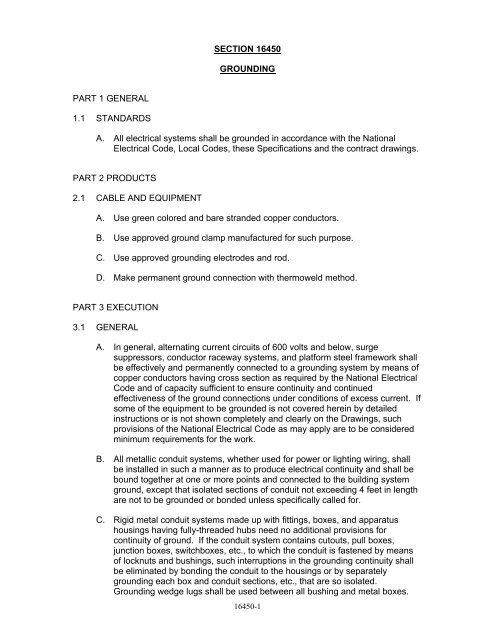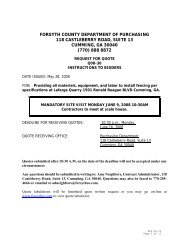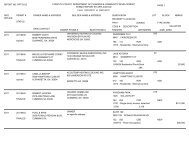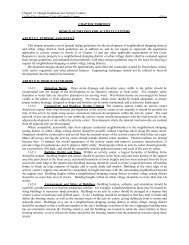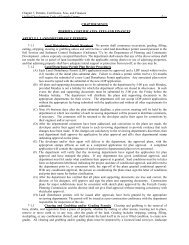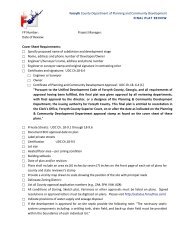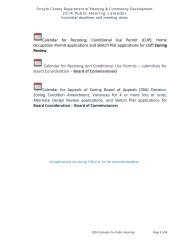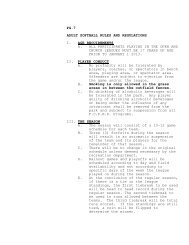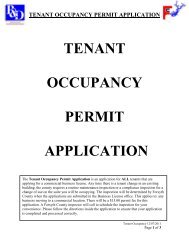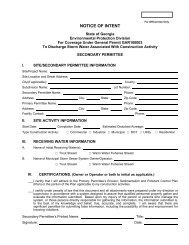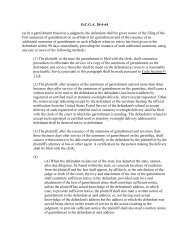SECTION 16450 GROUNDING PART 1 GENERAL 1.1 ...
SECTION 16450 GROUNDING PART 1 GENERAL 1.1 ...
SECTION 16450 GROUNDING PART 1 GENERAL 1.1 ...
Create successful ePaper yourself
Turn your PDF publications into a flip-book with our unique Google optimized e-Paper software.
<strong>SECTION</strong> <strong>16450</strong><strong>GROUNDING</strong><strong>PART</strong> 1 <strong>GENERAL</strong><strong>1.1</strong> STANDARDSA. All electrical systems shall be grounded in accordance with the NationalElectrical Code, Local Codes, these Specifications and the contract drawings.<strong>PART</strong> 2 PRODUCTS2.1 CABLE AND EQUIPMENTA. Use green colored and bare stranded copper conductors.B. Use approved ground clamp manufactured for such purpose.C. Use approved grounding electrodes and rod.D. Make permanent ground connection with thermoweld method.<strong>PART</strong> 3 EXECUTION3.1 <strong>GENERAL</strong>A. In general, alternating current circuits of 600 volts and below, surgesuppressors, conductor raceway systems, and platform steel framework shallbe effectively and permanently connected to a grounding system by means ofcopper conductors having cross section as required by the National ElectricalCode and of capacity sufficient to ensure continuity and continuedeffectiveness of the ground connections under conditions of excess current. Ifsome of the equipment to be grounded is not covered herein by detailedinstructions or is not shown completely and clearly on the Drawings, suchprovisions of the National Electrical Code as may apply are to be consideredminimum requirements for the work.B. All metallic conduit systems, whether used for power or lighting wiring, shallbe installed in such a manner as to produce electrical continuity and shall bebound together at one or more points and connected to the building systemground, except that isolated sections of conduit not exceeding 4 feet in lengthare not to be grounded or bonded unless specifically called for.C. Rigid metal conduit systems made up with fittings, boxes, and apparatushousings having fully-threaded hubs need no additional provisions forcontinuity of ground. If the conduit system contains cutouts, pull boxes,junction boxes, switchboxes, etc., to which the conduit is fastened by meansof locknuts and bushings, such interruptions in the grounding continuity shallbe eliminated by bonding the conduit to the housings or by separatelygrounding each box and conduit sections, etc., that are so isolated.Grounding wedge lugs shall be used between all bushing and metal boxes.<strong>16450</strong>-1
Paint and other nonconducting material shall be removed from the surface ofconduit, fittings, and metal housings prior to connecting grounding clamps,straps, or other devices.D. Equipment Grounding: Panel, starters, lighting fixtures, motor control center,etc., for power and lighting constitute the fundamental center of the associateddistribution systems. As such, the metallic enclosures, frames, and othernoncurrent carrying metal parts of this equipment shall be connected by oneor more grounding conductors to the grounding system. Install a groundconnection from the ground bus of switchgears, MCCs, and other electricalpanels with ground bus to the ground grid.E. All motor frames shall be grounded. The ground conductor shall be run insidethe conduit containing the power conductors. In the case of most 3-phasecircuits, this means a fourth conductor in each branch circuit. The groundingconductor may be as large as the power conductor or as small as allowed bySection 250 of the NEC but shall not be smaller than No. 12 AWG. Thegrounding conductor shall be stranded, with green insulation through No. 4AWG; larger sizes may be bare stranded. Ground connection at the motorshall be terminal lug or servit post inside motor conduit box and the other endconnected to the ground bus in the motor control center.F. Transformer Grounding: Bond the neutrals of outdoor substation transformersand distribution transformers within buildings to system ground network, andany additional grounding electrodes shown near the transformers. Connectthe case of the transformer to the grounding system as well.G. In making ground connections, the surfaces to all parts that will touch shall bethoroughly cleaned to ensure making good electrical contacts.H. All clamped joints shall be made up firmly. Thermal joints shall be equal toCaldwell Type TA. Where exposed to mechanical injury, the groundingconductor shall be suitably protected by pipe or other substantial guard. Ifguards are iron pipe or other magnetic material, the grounding conductor shallbe electrically connected to both ends of the guard to reduce impedance ofthe circuit.I. Grounding conductors shall be without splice or joint if applicable and shall bestraight and short except that when laid underground they shall be laid slackto prevent their being readily broken unless otherwise mechanically protected.J. No fuse, switch, circuit breaker, or similar disconnecting devices shall beinserted in the grounding conductor or connection throughout the entireinstallation.K. Grounding conductors shall be medium hard drawn, stranded bare copperwire sized as required by the National Electrical Code Article 250. ConductorsSize No. 6 and smaller may be solid; Size No. 4 and larger shall be stranded.Ground wire shall be carried in conduit to the grounding point.L. Ground rods where required, shall be of copper-clad steel not less than ¾-inch in diameter, 10 feet long or as shown on the Contract Drawings, anddriven full length into the earth. The maximum resistance of a single drivenground shall not exceed 5 ohms under normally dry conditions. If thisresistance cannot be obtained with a single rod, a minimum of 2 additional<strong>16450</strong>-2
ods shall be installed not less than 10 feet on center. Connections betweengrounding conductors and ground rods shall be mechanical if exposed,thermal if buried.M. Except where specifically indicated otherwise, all exposed noncurrent-carryingmetallic parts of electrical equipment, raceway systems, and neutral conductorof the wiring system shall be grounded. The ground connection shall be madeat the main service equipment and shall be extended to driven rods on theexterior of the building.N. All neutral conductor shall be continuous throughout the system and shall begrounded only at the point of origin of the service neutral.O. All receptacles shall have provision for grounding conductor connection, andshall be grounded to the grounding conductor and outlet box.P. All exposed steel columns, tanks, ladders, towers, and elevated platform shallbe effectively grounded using No. 2/0 or larger bare copper groundingconductors and driven ground rods. Where multiple columns or tanks must begrounded, ground points shall be interconnected by minimum No. 2/0 barecopper grounding conductors buried approximately 18 inches below finishedgrade.Q. Anchor bolts securing exposed electrical equipment, structures, metalenclosures, and tanks located outdoors shall be electrically connected to thesteel reinforcement in the concrete foundation or footing. Connection shallconsist of minimum No. 2/0 bare copper conductors and mechanicalgrounding clamps.R. Surge arrestor ground terminals shall be connected to the equipment groundbus. Ground paths for lightning and surge arresters and capacitors shall bekept as short and direct as practical. If possible, arresters shall be connectedin direct shunt relationship to the equipment terminals. Supporting bracketsshall be connected directly to the equipment frame.S. Grounding resistors, where specified, shall have a resistance within theboundary limits specified in IEEE Standard 142 in order to minimize transientovervoltages during ground faults. Ground fault current shall not be less thanthat required to operate protective devices or 25 amps, whichever is greater.T. Lightning and surge arresters used with grounded-wye systems which do nothave effectively grounded neutrals as defined by IEEE Standard 100 shallhave a voltage rating not less that the maximum phase-to-phase voltage ofthe system.U. The grounding system equivalent resistance shall not exceed 5 ohms for theentire system under normally dry conditions unless otherwise specified. Afterthe grounding system has been installed and all connections made, tests shallbe made by the Electrical Contractor to determine the resistance to earth. Ifthe resistance of the entire system exceeds the specified maximum, additionalground rods shall be driven to reduce the resistance to this value.V. Gas piping or piping conveying flammable liquids shall not be used asgrounding electrodes.<strong>16450</strong>-3
W. The use of salts or electrolytes to reduce earth resistance shall not bepermitted.X. Permanently connect the green ground conductor to each receptacle junctionbox (self-tapping screw).Y. Install a ground rod inside each manhole. Connect any metallic raceway andall noncurrent-carrying metal parts to the ground rod with a No. 6 AWG (min.)copper conductor. Similarly, provide a ground rod for every pole-mounted sitelighting and make grounding connections.Z. Bond the standby generator neutral to the grounding system with a properlysized grounding conductor. Ground the generator frame to the ground grid.AA. Ground metallic fences when used to enclose electrical equipment.3.2 TESTINGA. Ground resistance testing shall be done in accordance with IEEE standard 81-1993 to confirm that the resistance of the grounding system is 10 ohms orless (test shall not be run within 72 hours of last rain fall). Ground resistancetesting shall be done with the power off and the grounding electrodeconductor isolated from the utility, and the service to prevent coupling. Thetesting equipment shall use the fall of potential method of earth resistancemeasurement. The test equipment must be designed to reject the effects ofstray ac and dc currents on readings.B. A test report shall be submitted to the engineer and included in the O & Mmanual for the project. The report shall include but not be limited to:• Date of test• Time of day• Weather condition (ex. 82 o F, 82% RH, cloudy)• Date of last rain fall ≥ ½” in a 24 hour period• Soil type• Minimum of five (5) readings• A plot of all readings indicating a level spot in the curve at the systemresistance.C. All ground resistance testing shall be done in the presence of the Engineer. Iftest measurements indicate a grounding system resistance of greater than 10ohms, additional grounding cable shall be buried in locations and at thedirection of the Engineer. Ground resistance testing as described herein shallbe repeated after the additional ground cable has been installed. Theinstallation of grounding cable and repeat testing shall be done until the 10ohm grounding system resistance has been achieved.D. Test equipment for ground resistance measurement shall be Vibroground byAssociated Research, Megger null balance by Biddle, or alternate approvedby the Engineer.END OF <strong>SECTION</strong> <strong>16450</strong><strong>16450</strong>-4


